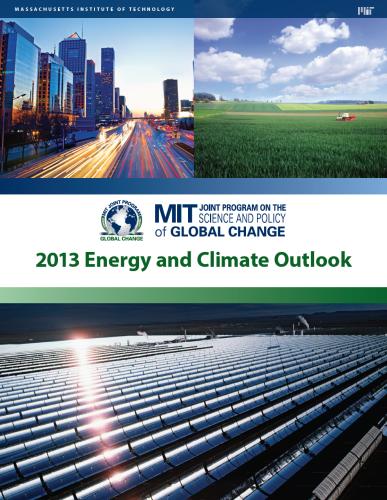2013 Energy and Climate Outlook

MIT News Story: Current Efforts Not Enough to Prevent Climate Consequences
Climate change is one of the forces of global change that will shape how the world feeds, shelters, transports, and otherwise attends to a population projected to exceed 10 billion people by 2100. The 2013 Energy and Climate Outlook provides an integrated assessment of how human activities, given our current development path, are interacting with complex Earth systems and ultimately affecting the natural resources on which we depend. It uses a projection modeling system developed by MIT’s Joint Program on the Science and Policy of Global Change, the Integrated Global Systems Model (IGSM) framework, to determine the associated energy, climate, atmosphere, ocean, and land-use implications. As in the 2012 edition of the Outlook, we provide a projection, not a prediction, as the future will be determined by actions taken over the next decades that are intended to stabilize our relationship with the planet.
Supplemental data for the Outlook includes a detailed set of projections through the year 2050 for each of 16 major regions of the world. We provide this numerical data in the hopes that researchers and policymakers will find them useful for their own analyses.
Download: Outlook 2013 data tables
As in the 2012 Outlook, we incorporate the emissions targets currently proposed by the international community to address the challenges of climate change. The United Nations Framework Convention on Climate Change (UNFCCC) reached an accord in 2009 for the so-called Copenhagen pledges, which were further specified in the Cancun agreements. Our objective is to show how far the current 2020 pledges take us, and what is at risk if we fail to push beyond these emissions reduction goals.
Broad conclusions have not substantially changed from the 2012 Outlook.
The major findings are as follows:
- The Copenhagen-Cancun pledges will nearly stabilize emissions in developed countries, but global emissions will continue to grow rapidly (total global GHG emissions in 2100 will be almost 95% higher than 2010 emissions).
- Most emissions growth will occur outside the developed countries, with growth concentrated in other G20 nations and the rest of the world (total GHG emissions from those regions combined grow by almost 150% from 2010 to 2100).
- While further cuts in developed countries would be useful, such cuts will have less impact on global emissions over time because, given Copenhagen-Cancun pledges, by 2100 emissions from developed countries are only about 13% of global GHG emissions.
- While emissions from fossil fuels are sizeable, other greenhouse gas emissions are also important (accounting for about 1/3 of total global GHG emissions by 2100) and cannot be ignored if more stringent stabilization and temperature goals are to be achieved. Reductions in these emissions are often the most cost effective. If policies to reduce them fail, a major opportunity to limit climate change may be missed.
- The transition to alternative energy has begun in developed countries and China, but the Copenhagen-Cancun pledges do not provide enough incentive to create the transformation needed in the energy system – such as wide-scale adoption of renewables, carbon capture and storage, or alternative propulsion systems in vehicles. In particular, by 2050 renewables compose only 5% of the global electricity mix.
- Population growth will drive increased electricity production as well as growing emissions (global electricity production increases by about 85% from 2010 to 2050 and CO2 emissions from electricity grow by 46%. Electricity’s share of total global CO2 emissions slightly decreases from about 36% in 2010 to 33% in 2050).
- Population and income growth will fuel a significant increase in the vehicle fleet and cause CO2 and other pollutant emissions to increase, especially in developing regions (the global vehicle fleet doubles by 2050 and among other G20 countries the fleet grows by about 3.6 times. Emissions from transport grow by about 60% from 2010 to 2050, and remain about 20% of total global CO2 emissions).
- Global change will accelerate with changes in global and regional temperatures, precipitation, land use, sea level rise and ocean acidification (temperature is projected to increase by 3.5-6.5oC by 2100 relative to the 1901-1950 mean, the global precipitation anomaly increases from 0.02 mm/day in 2010 to a range of 0.25-0.42 mm/day in 2100, global sea level rise due to thermal expansion increases from 0.1 m in 2010 to a range of 0.4-0.62 m in 2100, and ocean acidity changes from 8.05 pH in 2010 to about 7.85 pH in 2100).
